Imagine stepping on board a plane and placing your cabin baggage in a delivery system so that by the time you get to your seat, it is waiting for you in the bin overhead. Sitting down, the seat would then morph to accommodate your body shape, while adapting the humidity around you and absorbing some of your surplus energy to power the aircraft.
Looking out of its transparent walls as you fly, you notice a mountain in the distance and wonder what it is – thanks to a holographic projection that pops up, you are immediately informed of its name and height.
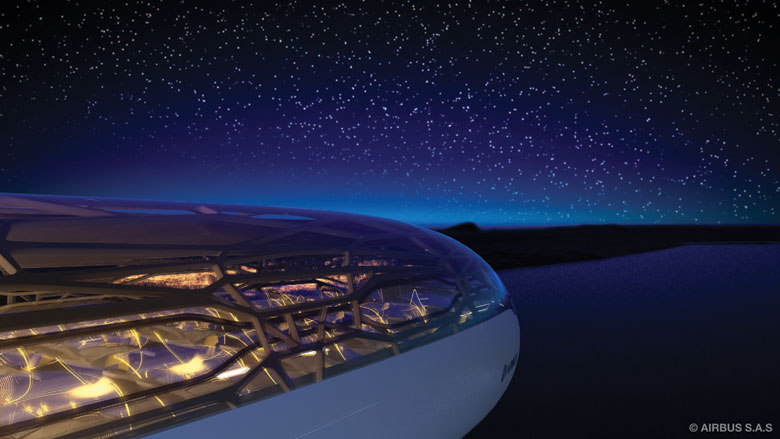
This is a glimpse inside the Airbus Future Concept Plane, part of the aircraft manufacturer’s 2050 vision of the future. Ian Scoley, head of industrial design for Airbus, says in a video interview on airbus.com: “The cabin membrane allows the interior to go transparent or opaque or even control the quality of the air that comes in, so if you are feeling tired or dehydrated it can bring water or ionisation into the air to make you feel better.
“We are using holographic displays and intelligent gestural controls, which mean we have a virtual environment combined with a human environment – one second you’re trying on clothes with a virtual screen, and the next you could be having a beer with someone on the other side of the planet.”
Instead of traditional economy, business and first class sections, the mid- to long-haul Concept Plane, with a capacity of between 250 and 350 passengers, would feature three key zones – Vitalising, Interaction and Smart Tech. The first, located at the front of the light-filled, glass-roofed aircraft, would offer panoramic views. Recline in a seat here and you could experience a “sound shower”, electronic acupressure therapy, a gentle breeze or the scent of eucalyptus, antioxidant-enriched air and vitamins, and lighting to suit your mood.
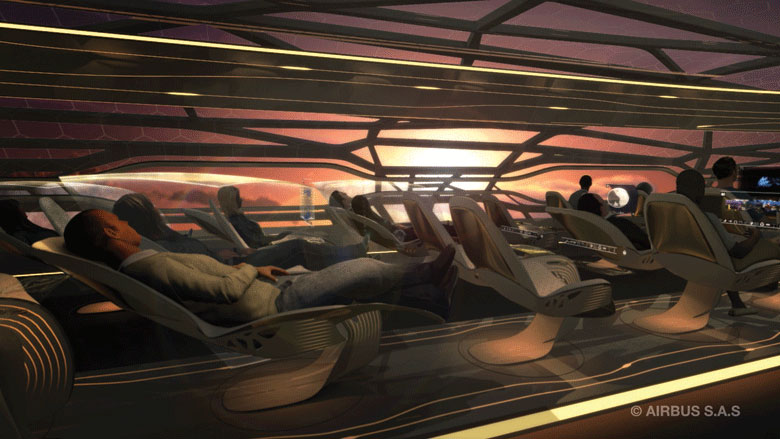
“Each zone is offering a unique experience but one that is linked to your budget, so the more you pay, the more access you have to the benefits this technology offers,” says Jorg Schuler, vice-president of cabin and cargo for Airbus.
Once restored, you move to the central Interaction Zone to play a round of virtual golf or enjoy a cocktail at the pop-up bar, before returning to your seat in the Smart Tech zone at the back to enjoy a film or talk to your family back home on your personal, gesture-controlled heads-up display.
The entire aircraft would also be fully connected, allowing you to make phone calls and access the internet at any point. For those who desire privacy to conduct a business meeting or enjoy a romantic dinner, pods would allow them to conduct video-conferencing, while projections on the walls could be tailored to create a customised environment.
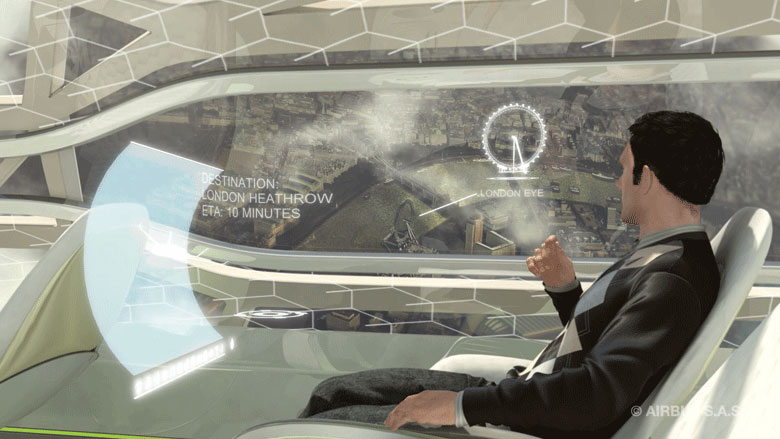
Admittedly, this is future gazing taken to its limits, and even Airbus admits that this plane will probably never exist, and certainly not in 40 years. But does it matter? “We don’t expect everything to exist in the way we have described,” Schuler says. “It’s a kind of engineer’s dream to enable us to look ahead at how air travel could be. It’s a free-thinking way of bringing innovation to the cabin and the whole aircraft. The next step is to work out how we reach this point – you will see parts of it in the future.”
So what kinds of technologies might be used in years to come? Taking inspiration from nature, Airbus has envisioned a bionic structure similar to that of a bird bone – hollow in places and light and strong where it’s meant to be, it could replace the solid aluminium fuselage of planes today. Instead of glass, a transparent biopolymer membrane, similar to the technology used in the dimmable windows of Boeing’s B787 Dreamliner, could respond to a sweep of the hand and control the amount of light coming in, while 3D printing of components, along with self-cleaning, self-repairing materials, could all be employed by manufacturers.
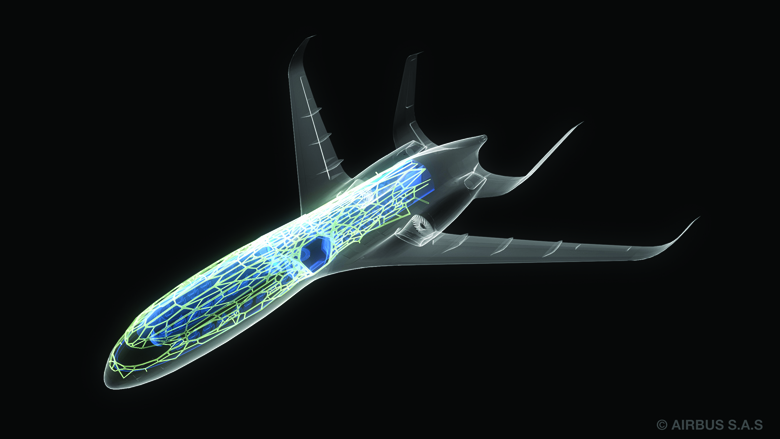
In reality, most aircraft flying in 2050 will not appear significantly different because, as Randy Tinseth, vice-president of marketing for Boeing, highlights: “The lifespan of an aircraft is 25 to 30 years. We are going to build B787s for 20 years or more so you are going to have those planes out on the market for 40 or 50 years into the future, maybe even longer.” According to a businesstraveller.com poll asking which aircraft out of the A380, B787, B747-800 or A350 XWB would be most important to the future of aviation, most (41.5 per cent) considered it to be the Dreamliner.
This is probably true, as the B787, which saw its first delivery in September last year, is the most innovative plane in our skies today, sporting not only the world’s first single-piece carbon composite fuselage, allowing for a lower cabin altitude and higher humidity, but “smooth ride technology” to dampen turbulence, a gaseous air filtration system to remove bacteria and odours, electrochromic windows and glowing LED mood lighting to make it feel more spacious (see “Living the dream”).
Such features are likely to become standard in the years to come, and many are being incorporated into other planes, such as the B747-800 and B737 Max. But, as Tinseth says, the evolution of design never ends. “We are looking at all things at all times in terms of plane capabilities. The interior experience is about building on what you have learnt and responding to passengers’ changing desires and needs. You are always perfecting what you have but we won’t see a change in direction until that next all-new plane, which probably won’t come until sometime in the next decade.”
That all-new plane has probably already been conceptualised by NASA. In 2010, its Fundamental Aeronautics Programme saw teams led by General Electric, MIT, defence corporation Northrop Grumman and Boeing come up with designs for cleaner, quieter, more fuel-efficient and more comfortable aircraft in 2030.
Incorporating sci-fi sounding “shape memory alloys, ceramic or fibre composites, carbon nanotube or fibre optic cabling, self-healing skin, hybrid electric engines, folding wings, double fuselages and virtual reality windows”, the aircraft range from MIT’s 180-passenger D8 Series “Double Bubble”, which combines two fuselages side by side with three turbofan jet engines on the tail, to Boeing’s 154-seat, twin-engine Sugar Volt, with hybrid propulsion and a truss-braced wing.
Rich Wahls, chief scientist on NASA’s Subsonic Fixed Wing project, says: “By putting these timeframes further out than the next generation, it enables or causes people in the industry to look beyond the next aircraft. We put goals out there that are very challenging but are in the realms of possibility. They cause very smart people to think differently and that can lead to innovation. Some of those things won’t happen right away, but you have identified the need so in ten or 20 years you can do it.”
In August, NASA demonstrated the Boeing X-48C prototype hybrid wing-body aircraft at Edwards Air Force Base in California. The 6.5-metre-wide, remote-controlled scale model flew for nine minutes, proving the design – which sees the wings blended with the fuselage to create a triangular shape – could operate landings and take-offs just as well as a conventional tube and wing plane.
It is anticipated that the X-48C could be used for commercial flights in 15 or 20 years. Wahls says: “Historically, when you look at something that is a really big change, you see it show up in the military before the commercial guys accept the risk and make the investment.” He adds: “I am hopeful though – from what I see, it is viable.”
Another exciting prospect is the return of supersonic, something NASA is also working on. “The real key is enabling supersonic over land, which means minimising the sonic boom – if a supersonic aircraft flies over you, you will hear a kind of thunderclap as you are flying faster than the speed of sound, which generates a shockwave; a rapid pressure change,” Wahls says.
“We have been trying to quantify the sound of the sonic boom to work out what is more objectionable for people inside and outside houses. Research is looking at how to shape the aircraft to reduce the size of that shockwave to make the pressure jump less sharp. Everything in aircraft design is a trade – so if you reduce the boom you also have to try to keep the drag low because if you are quiet but gobble fuel then you don’t have a viable aircraft.”
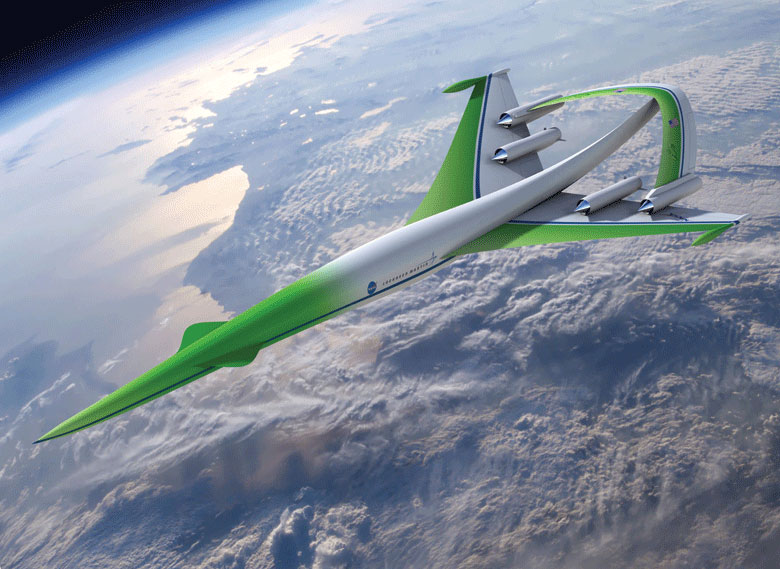
Still, it might not be too long before we see a return to Concorde-level speeds, as Wahls predicts a supersonic business jet “much sooner than 2050”.
Could there be a revolution in cabin design, too? Norm Thompson, deputy chief executive of Air New Zealand, which unveiled its unique Skycouch concept in 2010, says: “Providing as much comfort as possible to each passenger is the goal; however, this comes with the challenge of how much that comfort costs verses the customer’s preparedness to pay.
Unfortunately, current aircraft design does not allow significant mass to be retained at more than the current seat height in the aircraft. This significantly constrains the ability to be more innovative with the introduction, for example, of bunks.”
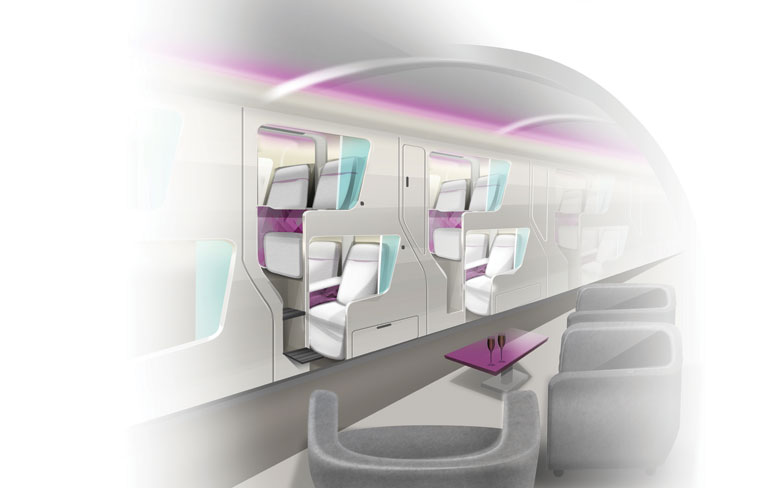
Bunk beds were something the Kiwi carrier investigated for business class passengers at its Hangar Nine research facility in Auckland when it was coming up with ideas for new products alongside the Skycouch. And it has not been alone in this thought process.
Paul Priestman, founding director of aircraft interior design company Priestmangoode, says: “There has been lots of discussion about why seats have to be in rows – why couldn’t you have a honeycomb structure with cabins that you crawl into like capsule hotels in Tokyo? It is an issue of flexibility – on a night flight it’s great but if you are doing a three-hour journey to Stuttgart, you don’t want to crawl into bed.”
James Park, managing director of another aircraft interior design firm, James Park Associates (JPA), says he would be “very excited” to see a “completely radical way of using the volume of an aircraft interior”. “We did an experimental project that involved stacking business class seats above each other so we had two levels down the centre of a wide-body aircraft, which actually worked well architecturally, but it would be a very long time until an aircraft manufacturer put it on board. By necessity the industry is risk-averse, and the cost of developing such a thing is astronomical,” he says.
Priestman adds: “As with any concept, it needs to be based on some sort of reality. We have had concepts with windows in the ceiling of the aircraft, but what benefits do you get? When we did the concepts for the A380 and A350 we had restaurants and libraries, but it’s about making use of that space. Flexibility is critical and every airline is struggling to make money, so they need to maximise every single square millimetre to economic effect.”
He also believes that in the future, more could be done to improve the welcome area of a plane, especially for those flying first or business. “Boarding an aircraft has always been like entering a hotel through the back door rather than the front because you go past the toilets and the kitchen. Then you get some grotty aluminium trolley coming down the aisle with some newspapers slung on it – you wouldn’t get that in Harrods.” Perhaps Airbus is on the right track after all.
Ten trends shaping the future of flight
1) GREYING SOCIETY: As human lifespan increases, the proportion of elderly people will go up. It is suggested that by 2050, the average person may live to 100. As a consequence, transporting dozens of passengers with reduced mobility on any one flight will become a challenge every airline will have to prepare for.
2) FEMALE FORCE: In the 1970s, only about 1 per cent of business travellers were women – now it is almost 50 per cent. With the global population set to increase from seven billion to nine billion by 2050, and increased opportunities for the fairer sex, savvy airlines will be looking at ways to tap into this market.
3) OBESITY: In the US, about 36 per cent of adults are overweight, up from 13 per cent in the 1960s. With more people trying to squeeze themselves into seats (the average width in economy is 17-18 inches), airlines may be forced to offer wider seats.
4) BRIC POWER: As the populations of Brazil, Russia, India and China vie for global dominance, their booming wealth and growing middle classes mean they are burgeoning air travel markets, and they are only going to continue to expand in the future. Extensive route networks and state-of-the-art airports will be vital.
5) CONNECTIVITY: More than 12 major airlines already allow in-flight mobile phone use, and many more are becoming wifi-enabled. In the coming decades, onboard connectivity will be the norm.
6) WELL-BEING: Raymond Kollau, founder of airlinetrends.com, says: “Mood lighting can be used to change the biorhythm of the passenger on board. It seems to help.” He predicts that quiet or family zones will be more commonplace. Improved air quality, decreased noise and self-cleaning materials will also contribute to passenger well-being.
7) GREAT EXPECTATIONS: James Park says: “Customer demands are shaping our design significantly. We will see lighter, more stylish, comfortable and efficient seats and better use of space.”
8) SUSTAINABILITY: The International Air Transport Association (IATA) is calling for a 50 per cent reduction in C02 levels (compared with 2005) by 2050, and the EU Emissions Trading Scheme came into play this year. Biofuels, recycling, lighter materials and improved fuel efficiency will be ever more important.
9) NEED FOR SPEED: Concorde may be dead and gone, but supersonic is likely to make a return. The main issues are environmental, making it economically viable as fuel burn is high, and the sonic boom, which is a problem when flying over land.
10) REDUCED NOISE: Boeing’s Dreamliner is 60 per cent quieter than standard planes during take-off and landing, and as technology improves and aircraft are upgraded, noise pollution will be reduced across fleets. Cabin noise will also be lessened.








